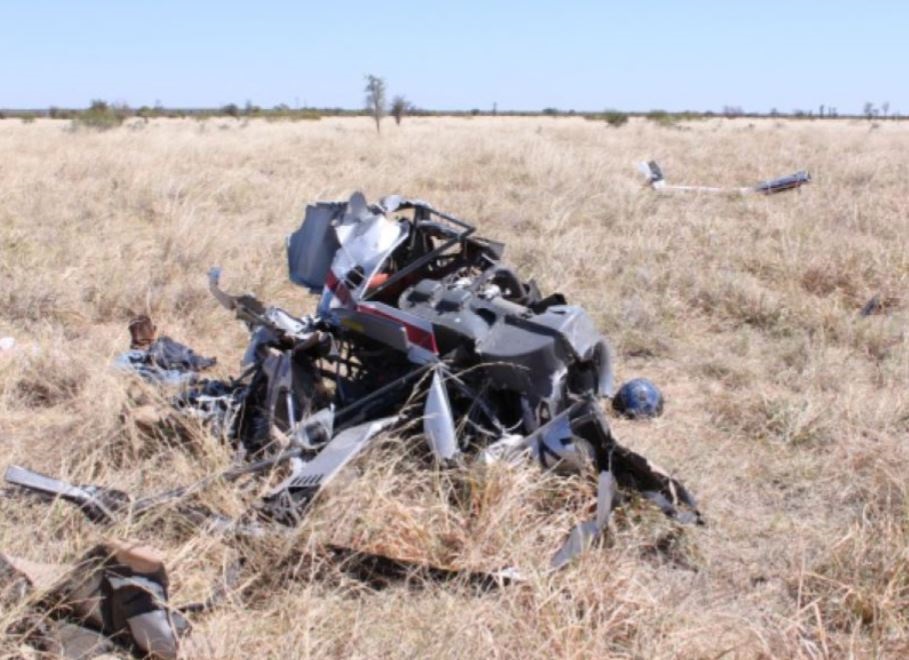- Pilots must operate within personal limits when flying in darker environments. Night ratings and instrument ratings entitle pilots to fly at night, but the skills needed to fly over a city at night are very different from the skills necessary to fly when there is nothing to be seen.

Ten minutes after the end of daylight on 27 July 2011, the pilot of a Robinson R22 helicopter took off from Big Rock Dam stockyards on Brooking Springs station to fly back to the homestead, a flight that would normally take 30–40 minutes.
The route normally used flew over an area devoid of ground lighting, then over a limestone ridge to a plain, from which the lights of Fitzroy Crossing would come into view. At some point from there, the flight would be diverted to the Brooking Springs homestead.
The pilot took off at about sunset, and initially flew at normal cruising speed, but gradually slowed until the helicopter orbited over a dirt track before heading towards Fitzroy Crossing. Thirty minutes after the end of daylight, the helicopter flew very low and very slow, possibly flying by reference to terrain visible through illumination from the helicopter’s landing lights. Ten minutes later, when it would have been fully dark, the helicopter climbed from about 100 ft to 600 ft above ground level, and turned towards the homestead. During the turn, the helicopter increased groundspeed from 5 to 95 knots, attained a rate of descent, and collided with the terrain. The pilot sustained fatal injuries during the accident.
The pilot had never received night flying training or obtained a Night Visual Flight Rules rating. The aircraft was equipped with suitable lighting for night flight, but it did not have the necessary instrumentation or other equipment necessary to enable a pilot to fly safely by night.
In this accident it is likely that the pilot lost control of the helicopter due to spatial disorientation from insufficient visual reference to keep the helicopter the right way up.
Lessons learnt
Many things must be in place for a safe night flight to happen. Do not fly at night unless you are trained and qualified to do so and you know all the requirements and are able to apply them.
A flight that cannot be completed by nightfall should not even be started unless all the necessary requirements are in place to allow a safe night flight and landing.
In very dark conditions such as rural areas, the skills needed to fly an aircraft at night are vastly different to day VFR flight, and may even exceed the capabilities of some pilots trained in night VFR operations.
Key message
The extra risks inherent in visual flight at night are from reduced visual cues, and the increased likelihood of perceptual illusions and consequent risk of spatial disorientation. These dangers can, however, be managed effectively. This report explains how suitable strategies can significantly reduce the risks of flying visually at night.
- Night flying is more difficult than flying in the day. Ensure you are both current and proficient with disciplined instrument flight. Know your own personal limitations in terms of flying with minimal or no visual references. Only fly in environments that do not exceed your capabilities.
- Before committing to departing on a visual flight at night or close to last light, ensure your aircraft is appropriately equipped and consider all obtainable operational information, including the availability of celestial and terrestrial lighting.
- Some nights and some terrain are darker than others. Excellent visibility conditions can still result in no visible horizon or contrast between sky and ground. Inadvertently flying into instrument meteorological conditions (IMC) is also harder to avoid at night.
- Always know where the aircraft is in relation to terrain, and know how high you need to fly to avoid unseen terrain and obstacles.
- Remain aware of illusions that can lead to spatial disorientation—they can affect anyone. Know how to avoid and recover from illusions by relying on instrument flight.
Read more about: Visual flight at night accidents
Read the report: Collision with terrain involving Robinson R22 helicopter, VH-YOL, 14 km north-west of Fitzroy Crossing, Western Australia, on 27 July 2011
Learn more about: Flying with reduced visual cues


